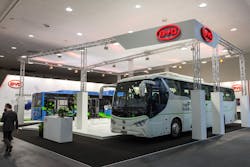BYD Launches Zero Emission Partnership with Los Olivos Elementary School District
China’s largest electric vehicle maker BYD is partnering with the Los Olivos Elementary School District, will bring a BYD Type A electric school bus, “The Achiever” to students in Santa Barbara County and create the first U.S. school district to have a 100% zero-emission fleet of school buses.
Members of the Sheet Metal, Air, Rail and Transportation (SMART) workers Union, Local 105, will perform final assembly on the bus at BYD’s manufacturing facility in Lancaster, California.
“Since we began this process, our goal was to be the first school district in the Santa Ynez Valley to have a fleet that could serve our students and our community, and through this partnership we have accomplished just that,” said Ray Vazquez, Superintendent/Principal of Los Olivos Elementary. “Our electric bus will provide cleaner transportation and benefit our community by decreasing our carbon footprint. On behalf of the Los Olivos school district and the community, we are thrilled to partner with BYD.”
ChargePoint, an electric vehicle charging network, will provide charging infrastructure to Los Olivos School District for the Type A school bus.
About the Author
EnergyTech Staff
Rod Walton is senior editor for EnergyTech.com. He has spent 17 years covering the energy industry as a newspaper and trade journalist.
Walton formerly was energy writer and business editor at the Tulsa World. Later, he spent six years covering the electricity power sector for Pennwell and Clarion Events. He joined Endeavor and EnergyTech in November 2021.
He can be reached at [email protected].
EnergyTech is focused on the mission critical and large-scale energy users and their sustainability and resiliency goals. These include the commercial and industrial sectors, as well as the military, universities, data centers and microgrids.
Many large-scale energy users such as Fortune 500 companies, and mission-critical users such as military bases, universities, healthcare facilities, public safety and data centers, shifting their energy priorities to reach net-zero carbon goals within the coming decades. These include plans for renewable energy power purchase agreements, but also on-site resiliency projects such as microgrids, combined heat and power, rooftop solar, energy storage, digitalization and building efficiency upgrades.
